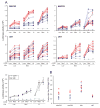Macrophage entry mediated by HIV Envs from brain and lymphoid tissues is determined by the capacity to use low CD4 levels and overall efficiency of fusion
- PMID: 17084877
- PMCID: PMC1890014
- DOI: 10.1016/j.virol.2006.09.036
Macrophage entry mediated by HIV Envs from brain and lymphoid tissues is determined by the capacity to use low CD4 levels and overall efficiency of fusion
Abstract
HIV infects macrophages and microglia in the central nervous system (CNS), which express lower levels of CD4 than CD4+ T cells in peripheral blood. To investigate mechanisms of HIV neurotropism, full-length env genes were cloned from autopsy brain and lymphoid tissues from 4 AIDS patients with HIV-associated dementia (HAD). Characterization of 55 functional Env clones demonstrated that Envs with reduced dependence on CD4 for fusion and viral entry are more frequent in brain compared to lymphoid tissue. Envs that mediated efficient entry into macrophages were frequent in brain but were also present in lymphoid tissue. For most Envs, entry into macrophages correlated with overall fusion activity at all levels of CD4 and CCR5. gp160 nucleotide sequences were compartmentalized in brain versus lymphoid tissue within each patient. Proline at position 308 in the V3 loop of gp120 was associated with brain compartmentalization in 3 patients, but mutagenesis studies suggested that P308 alone does not contribute to reduced CD4 dependence or macrophage-tropism. These results suggest that HIV adaptation to replicate in the CNS selects for Envs with reduced CD4 dependence and increased fusion activity. Macrophage-tropic Envs are frequent in brain but are also present in lymphoid tissues of AIDS patients with HAD, and entry into macrophages in the CNS and other tissues is dependent on the ability to use low receptor levels and overall efficiency of fusion.
Figures







References
-
- An SF, Groves M, Gray F, Scaravilli F. Early entry and widespread cellular involvement of HIV-1 DNA in brains of HIV-1 positive asymptomatic individuals. J Neuropathol Exp Neurol. 1999;58(11):1156–62. - PubMed
-
- Ancuta P, Bakri Y, Chomont N, Hocini H, Gabuzda D, Haeffner-Cavaillon N. Opposite effects of IL-10 on the ability of dendritic cells and macrophages to replicate primary CXCR4-dependent HIV-1 strains. J Immunol. 2001;166(6):4244–53. - PubMed
Publication types
MeSH terms
Substances
Associated data
- Actions
- Actions
- Actions
- Actions
- Actions
- Actions
- Actions
- Actions
- Actions
- Actions
- Actions
- Actions
- Actions
- Actions
- Actions
- Actions
- Actions
- Actions
- Actions
- Actions
- Actions
- Actions
- Actions
- Actions
- Actions
- Actions
- Actions
- Actions
- Actions
- Actions
- Actions
- Actions
- Actions
- Actions
- Actions
- Actions
- Actions
- Actions
- Actions
- Actions
- Actions
- Actions
- Actions
- Actions
- Actions
- Actions
- Actions
- Actions
- Actions
- Actions
- Actions
- Actions
- Actions
- Actions
- Actions
Grants and funding
LinkOut - more resources
Full Text Sources
Molecular Biology Databases
Research Materials

